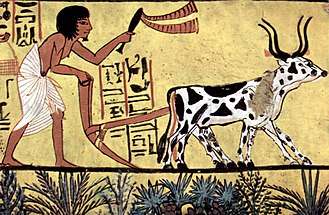Agricultural technology
Agricultural technology or agrotechnology (abbreviated agritech, AgriTech, or agrotech) is the use of technology in agriculture, horticulture, and aquaculture[1] with the aim of improving yield, efficiency, and profitability. Agricultural technology can be products, services or applications derived from agriculture that improve various input/output processes.
| Agriculture |
|---|
 |
|
Categories
|
|
|
History
A major turning point for agricultural technology is the Industrial Revolution.
Types of agricultural technology
Technologies and applications in agricultural technology include:
- Drones
- Satellite photography and sensors
- IoT-based sensor networks
- Phase tracking
- Weather forecasts
- Automated irrigation
- Light and heat control
- Intelligent software analysis for pest and disease prediction, soil management and other involved analytical tasks
- Biotech
Practical use-case of technology in agribusiness
Agriculture has been wrongly perceived in the past as a "dirty job" for the old people in rural communities but with the renaissance Technology brought to Agriculture, young people now see it as a potential sector to explore.
This is the practical use of Technology in Agriculture by a few start-ups in Africa.
Mobile application for agriculture
There is a Nigeria’s digital agriculture platform which focused on connecting farm sponsors with real farmers in order to increase food production while promoting youth participation in agriculture.
This agricultural technology startup is currently disrupting the agriculture ecosystem in the country by connecting small-scale farmers with investors using their platform App which is available on Google and Apple app stores.
Farmers and sponsors all receive a percentage of the profits on harvest. The platform also makes provision for insurance cover for all existing farm projects, so that in the event of unforeseen circumstances, the sponsors’ capital can be refunded.
Drones for agriculture advancements
Drones can be used on Crop field for scanning with compact multispectral imaging sensors, GPS map creation through onboard cameras, heavy payload transportation, and livestock monitoring with thermal-imaging camera-equipped drones.
High-income countries have seen recent improvements in their agricultural management systems through modern remote sensing technology, such as satellites and aircraft and the information they collect. Out of the vast amount of data collected, advice is provided to farmers and fishers to help inform their decisions.
This has led to better crop yields, higher quality produce and more sustainable agricultural practices in some cases. Big data also informs high-level decision-makers on how to better manage food supply at national and regional levels.
The use of small Unmanned Aerial Vehicles (UAVs) better known as 'drones' for agricultural purposes is a new emerging technology which could revolutionise the way agricultural entrepreneurs interact with their land, water, crops and infrastructure. UAVs can be made specifically for business use and farming in particular, they can capture geo-referenced, overlapping, high-resolution images (2–5 cm) of 400 hectares in a single flight; can seamlessly upload data and produce agricultural analytics from their data management systems, and fly autonomously from take-off to landing.
ICT for agriculture
Information Communication Technologies like podcasts, weblogs, social media platforms, e-books are constantly helping to bridge the information gap in the agriculture sector for farmers and agripreneurs.
Hydroponics technology
Hydroponics is a soilless farming technology that is used to grow vegetables and tomatoes.
It guarantees an all-year-round production for farmers and insulates these crops from the effects of climate change.
References
- "What is Agritech?". Sprout. Archived from the original on 30 December 2015. Retrieved 11 January 2016.